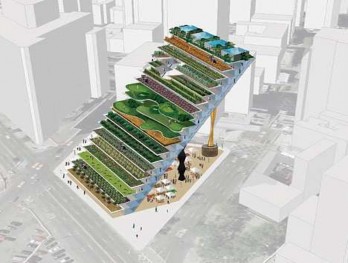Advantages of Vertical Farming
♤ Year-round crop production; 1 indoor acre is equivalent to 4-6 outdoor acres or more, depending upon the crop (e.g., strawberries: 1 indoor acre = 30 outdoor acres)
♤ No weather-related crop failures due to droughts, floods, pests
♤ All VF food is grown organically: no herbicides, pesticides, or fertilizers
♤ VF virtually eliminates agricultural runoff by recycling black water
♤ VF returns farmland to nature, restoring ecosystem functions and services
♤ VF greatly reduces the incidence of many infectious diseases that are acquired at the agricultural interface
♤ VF converts black and gray water into potable water by collecting the water of evapotranspiration
♤ VF adds energy back to the grid via methane generation from composting non-edible parts of plants and animals
♤ VF dramatically reduces fossil fuel use (no tractors, plows, shipping.)
♤ VF converts abandoned urban properties into food production centers
♤ VF creates sustainable environments for urban centers
♤ VF creates new employment opportunities
♤ We cannot go to the moon, Mars, or beyond without first learning to farm indoors on earth
♤ VF may prove to be useful for integrating into refugee camps
♤ VF offers the promise of measurable economic improvement for tropical and subtropical LDCs. If this should prove to be the case, then VF may be a catalyst in helping to reduce or even reverse the population growth of LDCs as they adopt urban agriculture as a strategy for sustainable food production.
♤ VF could reduce the incidence of armed conflict over natural resources, such as water and land for agriculture


